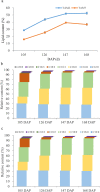Transcriptional profiling reveals differentially expressed genes involved in lipid biosynthesis during cacao seed development
- PMID: 31754164
- PMCID: PMC6872657
- DOI: 10.1038/s41598-019-53959-9
Transcriptional profiling reveals differentially expressed genes involved in lipid biosynthesis during cacao seed development
Abstract
Theobroma cacao is a plant of economic value due to the use of its seed lipid for chocolate, confectionery, and cosmetic industries. The seed lipid contains a stable ratio of saturated and unsaturated fatty acids, which determines its unique melting temperature. However, little is known about the molecular mechanism determining the fatty acid ratio and lipid content in cacao. To gain insight into the unique properties of lipid synthesis in cacao, biochemical and transcriptomic approaches were used to compare the lipid accumulation between high and low lipid content cacao accessions. Lipid accumulation rates and lipid content were different between the two accessions. Moreover, differentially expressed genes were detected between high and low lipid content cacao accessions. The data allowed the identification of distinct candidate genes and furthered our understanding of lipid accumulation, potentially explaining the differences in lipid content between various cacao accessions. The results might be used to develop molecular tools and engineer alternative pathways for cacao breeding with improved lipid production potentials.
Conflict of interest statement
The authors declare no competing interests.
Figures





References
-
- FAOSTAT. Crops production module [Internet]. [cited 11 Apr 2018], Available, http://faostat.fao.org/site/567/DesktopDefault.aspx?PageID=567 (2018).
Publication types
MeSH terms
Substances
LinkOut - more resources
Full Text Sources

